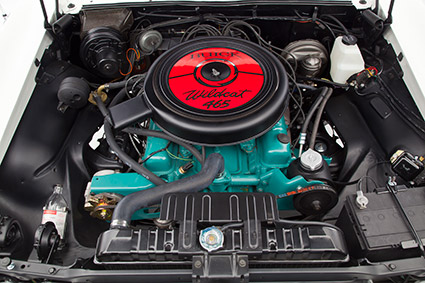Buick’s legendary V-8 engine from the mid-fifties to the mid-sixties is often called the “nailhead” motor due to its long, thin-stemmed valves with small diameter heads that resemble vertical rows of nails. The first Buick nailhead engines (debuting in 1953) had a 1.75″ intake and a 1.25″ exhaust valve, and even the later Wildcat 401 nailhead V-8s from the mid-sixties had valves that were much smaller than those used in Chevrolet engines at the time. However, the new Buick V-8 was light and compact overall and built with high quality forgings. Those qualities naturally attracted the attention of the hot rod crowd several years before the Chevy small block became available.
Buick’s nailhead V-8’s employed small-diameter intake runners to produce high torque since the small valves meant equally small and restrictive intake- and exhaust-port diameters. The nailheads also utilized camshafts with greater amounts of lift and duration than most powerplants of the day. The combination worked well enough though, and allowed the Buick engines to deliver more than one ft. lb. of torque per cubic inch of displacement. This is why Buick labeled and advertised their nailhead engines on their torque output, not the horsepower. The numbers resulted in some confusion though. For example, the Buick Wildcat 445 in the 1966 Skylark GS was actually a 401 cubic inch mill that developed 325 hp and a whopping 445 lb. ft. of torque. Buick’s focus on torque over maximum breathing at high rpm showed that the nailheads were designed to provide smooth, powerful acceleration to move big, heavy cars. High-rpm horsepower was obviously not the goal.
Although the nailhead’s valve orientation and head design allowed fairly decent-flowing intake ports, an extra bend in the exhaust ports made them quite restrictive, and Buick had to use very aggressive camshafts to make adequate power. The early nailheads boasted some of the most radical factory camshafts available at the time, and while the radical camshaft profiles did help air flow through the restrictive heads, they also delivered a somewhat lumpy idle compared to most other engines of the day.
That lumpy idle appealed to the hot rod crowd though, and for a few years before the Chevy small blocks and Chrysler hemi engines became widely available, the early nailhead Buicks powered many street rods, drag cars, road-race machines, and even Bonneville top-speed racers during the late ’50s. In 1967 a whole new generation of Buick V-8s with more conventional head designs appeared, and the nailhead was retired. Today, most nailheads are utilized on street rods or stock restorations due to the lasting appeal of their unique appearance and extreme low-end torque. Although it was eclipsed by later more free-flowing designs with more and larger valves, the venerable Buick nailhead has undeniably earned a well-deserved spot in GM powerplant history.

